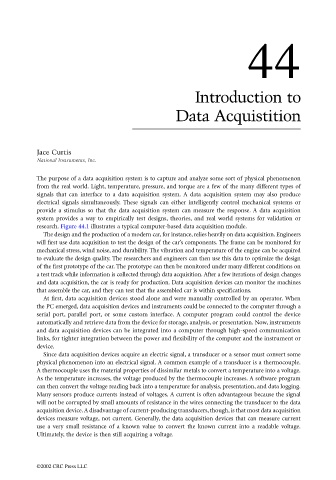Page 1157 - The Mechatronics Handbook
P. 1157
44
Introduction to
Data Acquistition
Jace Curtis
National Instruments, Inc.
The purpose of a data acquisition system is to capture and analyze some sort of physical phenomenon
from the real world. Light, temperature, pressure, and torque are a few of the many different types of
signals that can interface to a data acquisition system. A data acquisition system may also produce
electrical signals simultaneously. These signals can either intelligently control mechanical systems or
provide a stimulus so that the data acquisition system can measure the response. A data acquisition
system provides a way to empirically test designs, theories, and real world systems for validation or
research. Figure 44.1 illustrates a typical computer-based data acquisition module.
The design and the production of a modern car, for instance, relies heavily on data acquisition. Engineers
will first use data acquisition to test the design of the car’s components. The frame can be monitored for
mechanical stress, wind noise, and durability. The vibration and temperature of the engine can be acquired
to evaluate the design quality. The researchers and engineers can then use this data to optimize the design
of the first prototype of the car. The prototype can then be monitored under many different conditions on
a test track while information is collected through data acquisition. After a few iterations of design changes
and data acquisition, the car is ready for production. Data acquisition devices can monitor the machines
that assemble the car, and they can test that the assembled car is within specifications.
At first, data acquisition devices stood alone and were manually controlled by an operator. When
the PC emerged, data acquisition devices and instruments could be connected to the computer through a
serial port, parallel port, or some custom interface. A computer program could control the device
automatically and retrieve data from the device for storage, analysis, or presentation. Now, instruments
and data acquisition devices can be integrated into a computer through high-speed communication
links, for tighter integration between the power and flexibility of the computer and the instrument or
device.
Since data acquisition devices acquire an electric signal, a transducer or a sensor must convert some
physical phenomenon into an electrical signal. A common example of a transducer is a thermocouple.
A thermocouple uses the material properties of dissimilar metals to convert a temperature into a voltage.
As the temperature increases, the voltage produced by the thermocouple increases. A software program
can then convert the voltage reading back into a temperature for analysis, presentation, and data logging.
Many sensors produce currents instead of voltages. A current is often advantageous because the signal
will not be corrupted by small amounts of resistance in the wires connecting the transducer to the data
acquisition device. A disadvantage of current-producing transducers, though, is that most data acquisition
devices measure voltage, not current. Generally, the data acquisition devices that can measure current
use a very small resistance of a known value to convert the known current into a readable voltage.
Ultimately, the device is then still acquiring a voltage.
©2002 CRC Press LLC

